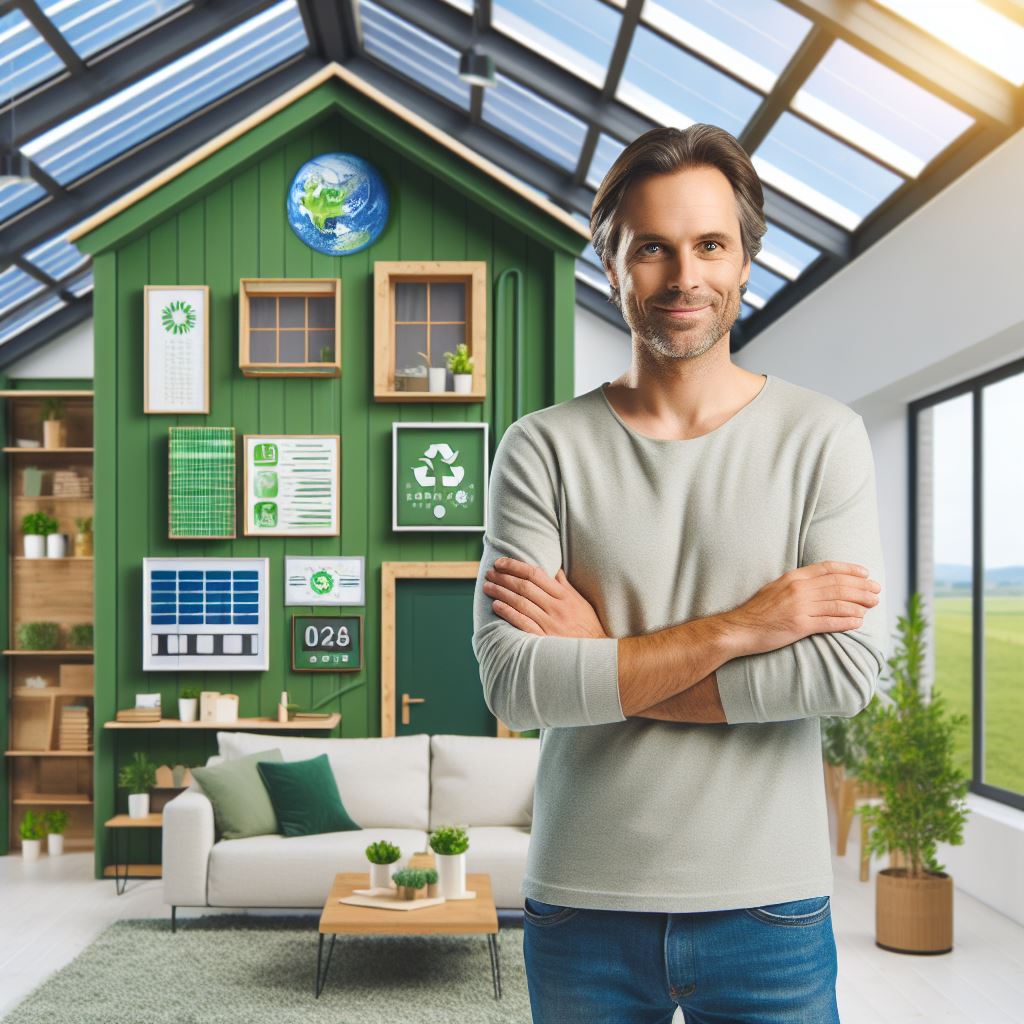Introduction
Green CRE investments are becoming increasingly crucial as the world grapples with climate change challenges.
Investors are recognizing the long-term benefits of sustainable real estate investments, such as reduced operational costs and increased property value.
The growth of green investments in the real estate industry highlights the sector’s commitment to sustainability and environmental conservation.
In 2024, the wave of green CRE investments is expected to reach its peak, with a surge in environmentally conscious developments.
This wave will be driven by factors such as stricter regulations, evolving market demands, and rising environmental awareness.
Investors will prioritize properties that have sustainable features, such as energy-efficient systems and materials, green certifications, and access to public transportation.
Green investments not only align with environmental goals but also offer financial advantages in terms of lower utility expenses and increased tenant demand.
Real estate developers and owners should seize the opportunities presented by the 2024 wave to incorporate green practices into their projects.
In fact, green CRE investments are gaining significance and are expected to witness substantial growth in the coming years.
By embracing sustainability and incorporating green features into their properties, investors can contribute to a cleaner and more sustainable future.
Current State of Green CRE Investments
Overview of current trends and statistics
Green CRE investments have gained significant traction in recent years, driven by the increasing awareness of environmental sustainability and the potential financial benefits.
As the world grapples with the consequences of climate change, the real estate industry has recognized its role in reducing carbon emissions and implementing sustainable practices.
This has led to a surge in green CRE investments, with developers and investors actively incorporating sustainable technologies and designs into their projects.
Current trends and statistics paint a positive outlook for the future of green CRE investments.
According to a report by JLL, global green building investments are projected to reach $42 billion by 2020.
The construction of green buildings is also expected to grow by 14% annually through 2021.
This growth can be attributed to the increasing availability and affordability of sustainable technologies such as solar panels and energy-efficient systems.
Benefits of green investments for investors and the environment
There are numerous benefits associated with green investments, both for investors and the environment.
In terms of environmental impact, investing in green CRE projects helps reduce greenhouse gas emissions and combat climate change.
Buildings account for a significant portion of carbon dioxide emissions globally, and green buildings address this issue by implementing energy-efficient measures and sustainable practices.
From an investor’s perspective, green investments offer attractive returns and strategic advantages.
Green buildings have shown to have higher resale value, attracting premium tenants and retaining higher occupancy rates.
Additionally, companies that incorporate green buildings in their portfolio enhance their corporate social responsibility efforts, contributing positively to their brand image and reputation.
Examples of successful green CRE projects
In addition to the financial and environmental benefits, there are also notable examples of successful green CRE projects around the world.
The Edge in Amsterdam, Netherlands, is widely recognized as the greenest building globally.
It features cutting-edge sustainable technologies, including solar panels, rainwater harvesting, and a smart lighting system.
Similarly, the Bullitt Center in Seattle, Washington, is a net-zero energy building that showcases innovative sustainable features such as rainwater harvesting, geothermal heating, and cooling systems.
Overall, the growth of green CRE investments signifies a positive shift towards a more sustainable future in the real estate industry.
As more developers and investors recognize the long-term benefits and potential returns of green projects, we can expect to see a continued surge in green investments, ultimately contributing to a more environmentally conscious and economically viable landscape.
Read: Self-Storage CRE: 2024’s Lucrative Niche
Factors Driving the 2024 Wave of Green CRE Investments
Government regulations and policies promoting sustainability
Government regulations and policies in favor of sustainability are playing a crucial role in driving the 2024 wave of green CRE investments.
These regulations create a favorable environment for developers, investors, and tenants to engage in sustainable practices.
The government’s focus on reducing carbon emissions and promoting renewable energy sources has led to the implementation of stringent regulations aimed at encouraging sustainable building practices.
By enforcing green building codes and energy efficiency standards, governments are pushing the real estate industry towards green investments.
Additionally, policies that offer tax incentives and grants to developers who adhere to sustainable practices further incentivize green investments.
These financial benefits not only reduce the upfront costs associated with green building projects but also provide long-term operational savings.
Increasing demand for sustainable buildings from tenants and consumers
Tenants and consumers are increasingly demanding sustainable buildings, thereby driving the 2024 wave of green CRE investments.
The growing awareness about climate change and environmental issues has led to a shift in preferences.
Tenants now prioritize renting or leasing spaces in green buildings.
They recognize the benefits associated with sustainable features, such as reduced energy consumption, improved indoor air quality, and enhanced occupant comfort.
As a result, developers are compelled to invest in green buildings to attract and retain tenants.
Consumers, too, are increasingly conscious of the environmental impact of their choices.
They prefer products and services offered by companies that operate in sustainable buildings.
This demand has a ripple effect on real estate investments, as retailers and businesses seek sustainable locations to align with consumer preferences.
The emergence of green building certifications and standards
The emergence of green building certifications and standards has been influential in driving the 2024 wave of green CRE investments.
Certifications like LEED (Leadership in Energy and Environmental Design) and ENERGY STAR provide a framework for measuring and recognizing sustainable building practices.
These certifications act as a quality assurance for investors, tenants, and consumers.
A building with a recognized green certification becomes an attractive investment option, as it guarantees certain sustainability standards.
Developers are, therefore, motivated to pursue these certifications to enhance the marketability and value of their properties.
Moreover, certified green buildings also offer operational benefits, including reduced energy and water consumption and lower maintenance costs.
These factors make green buildings a financially viable option for investors in the long run.
Financial incentives and tax benefits for green investments
Financial incentives and tax benefits provided for green investments are driving the 2024 wave of green CRE investments.
Governments at various levels offer a range of incentives to encourage developers and investors to pursue sustainable projects.
These incentives can include grants, subsidies, tax credits, and accelerated depreciation allowances.
By providing financial support, governments aim to offset the initial costs associated with green building projects and make them more attractive to investors.
Additionally, green investments offer long-term financial benefits.
Energy-efficient buildings have lower operational expenses, including reduced energy and water bills.
This results in improved cash flow and higher profitability for investors.
In short, the 2024 wave of green CRE investments is driven by a combination of factors.
Government regulations and policies, increasing demand from tenants and consumers, green building certifications, and financial incentives all contribute to the growing popularity of sustainable investments in the commercial real estate sector.
Read: Logistics Hubs: The New Goldmines?

Opportunities and Challenges for Green CRE Investors
As the wave of environmentally conscious investments sweeps across the commercial real estate (CRE) landscape in 2024, savvy investors are eagerly exploring the opportunities and challenges inherent in Green CRE Investments.
Exploring the Potential Returns on Green Investments
Green CRE investments offer a promising avenue for financial growth while contributing to sustainable development.
The demand for eco-friendly spaces is on the rise, driven by both regulatory requirements and a growing market preference for sustainable practices.
Investors stand to benefit from increased property values, reduced operational costs through energy efficiency, and enhanced marketability.
The integration of renewable energy sources, energy-efficient technologies, and sustainable design principles can lead to long-term savings and improved asset performance.
The adoption of green certifications, such as LEED or BREEAM, can further enhance the property’s market position, attracting environmentally conscious tenants and investors alike.
Risks and Challenges Associated with Green Projects
Despite the promising outlook, green CRE investments are not without their challenges.
The upfront costs of implementing sustainable technologies and features can be substantial, impacting initial project budgets.
Additionally, the rapidly evolving landscape of green technologies poses a risk of obsolescence, requiring investors to stay abreast of the latest advancements.
Market perception and tenant demand can also be unpredictable, potentially affecting occupancy rates and rental income.
Regulatory changes may introduce compliance challenges, further emphasizing the need for thorough due diligence and risk assessment.
Strategies to Mitigate Risks and Maximize Returns
To navigate the challenges, investors should adopt a strategic approach.
Conducting comprehensive feasibility studies, assessing the long-term cost benefits of green technologies, and staying informed about regulatory changes are crucial steps.
Diversifying investments across different green features and technologies can help mitigate risks associated with rapid technological advancements.
Engaging with experienced professionals, such as sustainable architects and consultants, can provide valuable insights into optimizing the performance of green projects.
Collaborating with financial institutions that offer green financing options and incentives can also ease the financial burden associated with upfront costs.
In a nutshell, while Green CRE investments present exciting opportunities, investors must approach them with a nuanced understanding of potential risks and employ strategic measures to maximize returns.
As the 2024 wave of environmentally conscious investments continues to gain momentum, those who navigate these opportunities and challenges adeptly stand to make a lasting impact on both the environment and their financial portfolios.
Read: Student Housing: CRE’s Rising Star in 2024
Green Technologies and Innovations Shaping the 2024 Wave
As we navigate the exciting landscape of Green Commercial Real Estate (CRE) Investments in 2024, it is imperative to delve into the technological advancements that are propelling sustainability in the industry.
This section explores the key green technologies that are steering the 2024 wave, the profound impact of these innovations on sustainability, and compelling case studies showcasing successful implementations.
Overview of Key Green Technologies in the Real Estate Industry
The arsenal of green technologies in the real estate industry has expanded exponentially.
Photovoltaic solar panels, advanced building materials, and smart energy management systems lead the charge.
Photovoltaic solar panels, with improved efficiency and decreased costs, are transforming buildings into energy-producing assets.
Meanwhile, cutting-edge materials such as recycled steel and sustainable concrete are redefining construction practices, reducing the industry’s carbon footprint.
Impact of Technology Advancements on Sustainability in CRE
Technology is a catalyst for change in sustainability, and its impact on Commercial Real Estate is transformative.
The integration of Artificial Intelligence (AI) and the Internet of Things (IoT) has enabled smart building systems that optimize energy consumption, monitor air quality, and enhance overall efficiency.
Blockchain technology is fostering transparency in property transactions, ensuring that sustainability features are accurately represented.
These advancements not only reduce operational costs but also position CRE as a leader in environmental responsibility.
Case Studies Highlighting Successful Implementation of Green Technologies
Real-world success stories exemplify the tangible benefits of embracing green technologies.
The revitalization of an outdated office building into a net-zero energy structure through the adoption of solar panels and energy-efficient systems showcases the financial viability of sustainable practices.
Additionally, a commercial development using recycled and upcycled materials not only reduced construction waste but also garnered widespread acclaim for its innovative design.
In essence, the second section of ‘Green CRE Investments: The 2024 Wave’ underscores the pivotal role of technology in shaping the sustainability landscape in Commercial Real Estate.
The embrace of these green innovations not only future-proofs investments but also propels the industry toward a more environmentally conscious and economically sound future.
Read: Warehouse Automation: The Next Wave
Tips for Real Estate Investors Looking to Jump on the Green Wave
Investing in green commercial real estate (CRE) projects is a smart move for forward-thinking investors.
With the increasing awareness of environmental issues and the need for sustainable development, the demand for green buildings and initiatives is on the rise.
To ensure the success of your green CRE investments, follow these tips:
Conducting thorough market research and analysis
Prior to making any investment decisions, it is crucial to conduct comprehensive market research and analysis specific to green CRE projects.
This step will enable you to understand the market demand, potential risks, and projected returns on investment.
Key aspects to consider include:
- Identifying the target market: Determine the demand for green properties in your chosen location or market segment.
- Evaluating competition: Analyze the existing green projects and assess their performance and market position.
- Understanding regulations and incentives: Familiarize yourself with local and national regulations, codes, and incentives related to green buildings.
Finding reliable partners and consultants in green investments
To navigate the complexities of green CRE investments, it is essential to work with experienced partners and consultants.
These professionals can provide valuable insights, expertise, and support throughout the investment process.
Consider the following when searching for reliable partners:
- Engage with green-focused real estate developers, architects, and contractors who have a proven track record in designing and constructing sustainable buildings.
- Hire consultants with expertise in green certification programs, such as LEED (Leadership in Energy and Environmental Design), to ensure your projects meet the necessary sustainability standards.
- Collaborate with energy auditors and sustainability consultants to identify energy-saving opportunities and achieve operational efficiency in your green properties.
Developing a long-term sustainability plan
A well-defined sustainability plan is vital for the long-term success of your green CRE investments.
Consider the following when developing your plan:
- Set clear sustainability goals and objectives that align with the market demand and industry standards.
- Establish metrics and tracking systems to monitor the environmental performance of your properties.
- Implement strategies for energy efficiency, water conservation, waste management, and indoor air quality.
- Educate tenants and occupants on green practices and provide resources to support their sustainable lifestyle.
Exploring financing options for green projects
Green CRE projects often require specialized financing options.
Consider the following financing avenues:
- Research government incentives and grants available for green building projects, energy-efficient upgrades, and renewable energy installations.
- Partner with banks and financial institutions that offer green financing programs specifically designed for sustainable projects.
- Explore crowdfunding platforms that specialize in funding green initiatives and connect with environmentally conscious investors.
- Consider green bonds, which are fixed-income investments specifically used to finance environmentally friendly projects.
By conducting thorough market research, finding reliable partners, developing a sustainability plan, and exploring financing options, investors can capitalize on the green wave in CRE.
Embracing sustainable development not only contributes to a healthier environment but also offers substantial long-term financial benefits.
Conclusion
In the rapidly evolving landscape of real estate investments, the significance of embracing sustainable practices cannot be overstated.
Green Commercial Real Estate (CRE) investments have proven to be more than just a trend; they are a pivotal force shaping the future of the industry.
As we conclude this exploration of the 2024 wave, it’s crucial to recap the enduring importance of integrating environmental, social, and governance (ESG) principles into CRE portfolios.
Green investments not only align with global efforts to combat climate change but also offer long-term financial benefits.
Sustainable buildings tend to attract higher tenant demand, command premium rents, and boast enhanced asset value.
Additionally, they contribute to the overall well-being of communities by promoting healthier living environments.
As we stand on the brink of the 2024 wave of green investments, it’s an opportune moment for investors to seize the potential embedded in sustainable CRE.
The market is evolving, and those who adapt to the changing tides will not only future-proof their portfolios but also actively participate in building a more sustainable world.
Embracing this wave involves a commitment to understanding and integrating green building practices, energy-efficient technologies, and innovative design strategies.
Investors should actively seek out opportunities that align with sustainability goals, recognizing the dual benefit of environmental impact and financial returns.




